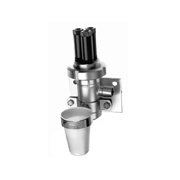Yokogawa hat viel Aufwand und Zeit in die Entwicklung einer breiten Palette von Armaturen investiert. Ein besonderer Schwerpunkt lag dabei auf der Senkung von Installations- und Wartungskosten und somit günstigeren Betriebskosten.
Ein hohes Maß an Standardisierung ermöglicht es, Elektroden mit DIN-Abmessungen direkt in die Armaturen einzusetzen. Für die meisten anderen Typen ist ein Montagesatz (als Zubehör) lieferbar. Eine große Auswahl an Konstruktionswerkstoffen ermöglicht dem Anwender, unter Berücksichtigung von chemischer Beständigkeit, Druck und Temperatur für jeden Prozess die optimale Lösung zu finden.
- Breite Auswahl an Konstruktionswerkstoffen.
- Ein hoher Standardisierungsgrad reduziert die Ersatzteilhaltung.
- Direktmontage von Sensoren mit DIN-Abmessungen.
- Flüssigkeitserde-Stift für stabile Messungen.
- Ausgelegt für hohe Drücke und Temperaturen.
- Chemische Reinigungssysteme optional erhältlich.
- Elektrolytisch polierte Edelstahlarmaturen für optimale Korrosionsbeständigkeit.
Publikationen
Wet scrubbers are used in utilities, paper mills, and chemical plants to remove sulfur dioxide (SO2) and other pollutants from gas streams. Undesirable pollutants are removed by contacting the gases with an aqueous solution or slurry containing a sorbent. The most common sorbents are lime, Ca(OH)2, and limestone, CaCO3.
For control of batch neutralization, a pH measurement coupled with a timer-controlled chemical feed scheme provides very satisfactory results.
This system can be adapted for either acid waste or alkaline waste neutralization.
One of the primary applications for high purity water is for boiler feed water. The measurement of pure water pH can be one of the quickest indicators of process contamination in the production or distribution of pure water. Effective chemical treatment of the feed water is vital in maintaining the useful operating life and minimizing maintenance costs of the boiler.
Industry:Power, Pharmaceutical, Common
The proliferation of microorganisms and the resultant formation of slime is a problem which commonly occurs in aqueous systems. Problematic slime producing microbes may include bacteria, fungi and/or algae. Slime deposits typically occur in many industrial aqueous systems including cooling water systems, pulp and paper mill systems, petroleum operations, clay and pigment slurries, recreational water systems, air washer systems, decorative fountains, food, beverage, and industrial process pasteurizers, sweetwater systems, gas scrubber systems, latex systems, industrial lubricants, cutting fluids, etc.
Industry:Refining, Food and beverage, Power, Oil and Gas, Pulp and Paper, Chemical
Process liquid analyzers such as pH meters, conductivity meters, ORP meters, and density meters play an important role at electrolysis plants in the control of concentrations of various process solutions. This requires both precision and stability under harsh conditions that include highly corrosive substances, high temperatures, and many impurities.
Cyanide-bearing wastewater from mining and electroplating facilities and certain types of chemical plants is toxic and must be treated by oxidation with chlorine or chloride to bring the cyanide concentration within regulatory limits.
Industry:Electrical and Electronics
Reverse osmosis (RO) is a separation process that uses pressure to force a solution through a membrane that retains the solute on one side and allows the pure solvent to pass to the other side. More formally, it is the process of forcing a solvent from a region of high solute concentration through a membrane to a region of low solute concentration by applying a pressure in excess of the osmotic pressure.
The control of the world's water resource is arguably one of the most important issues. Water demand from industry and domestic users is set to rise throughout the industrialized world. Yokogawa has been applying minimized maintenance measurement systems.
Sour Water is the wastewater that is produced from atmospheric and vacuum crude columns at refineries. Hydrogen sulfide and ammonia are typical components in sour water that need to be removed before the water can be reused elsewhere in the plant. Removal of these components is done by sending the sour water from the process to a stripping tower where heat, in the form of steam, is applied.
Power plant boiler houses designed to burn coal or high sulfur oil are required by Federal and State pollution regulations to "scrub" (remove) sulfur dioxide from flue gasses to meet emission limits. SO2 in flue gasses is known to be harmful to the environment, as it is one contributor to the formation of acid rain. pH control is critical for the proper functioning of the scrubber system.
Wastes have been considered to be a serious worldwide environmental problem in recent years. Because of increasing pollution, these wastes should be treated. However, industrial wastes can contain a number of valuable organic components. Recovery of these components is important economically. Using conventional distillation techniques, the separation of acetic acid and water is both impractical and uneconomical, because it often requires large number of trays and a high reflux ratio. In practice special techniques are used depending on the concentration of acetic acid.
Current trend for increasing mercury awareness throughout the public sector has caused the government to take action. Recently, the Environmental Protection Agency (EPA) has focused their efforts on controlling mercury levels produced in various coal fired power plants. Based on information from several case studies, the EPA developed the Mercury and Air Toxics Standards to cut back mercury emissions. The most popular technology utilized by coal plants to meet the new standards is a scrubber which cleans the off gas from the combustion process. ORP sensors can further monitor the effluent from these scrubbers to ensure optimal mercury emission levels are achieved. By closely monitoring the mercury concentrations in the effluent, plant managers will be able to easily confirm their plants are meeting the EPA's standards.
Downloads
Bedienungsanleitungen
Technische Dokumentationen
Möchten Sie weitere Informationen über unsere Mitarbeiter, Technologien und Lösungen?
Kontakt












